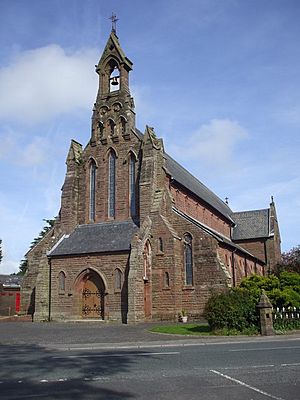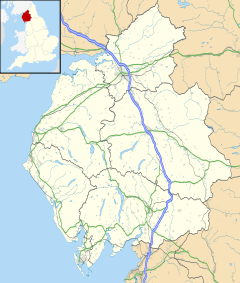Cleator Moor facts for kids
Quick facts for kids Cleator Moor |
|
|---|---|
| Town and parish | |
 St Mary's Catholic Church |
|
| Population | 6,936 (2011) |
| OS grid reference | NY021150 |
| Civil parish |
|
| Unitary authority |
|
| Ceremonial county | |
| Region | |
| Country | England |
| Sovereign state | United Kingdom |
| Post town | CLEATOR MOOR |
| Postcode district | CA25 |
| Dialling code | 01946 |
| Police | Cumbria |
| Fire | Cumbria |
| Ambulance | North West |
| EU Parliament | North West England |
| UK Parliament |
|
Cleator Moor is a town and civil parish in Cumbria, England. It is part of the historic county of Cumberland. In 2011, about 6,936 people lived there.
This town is located below Dent Fell. It is also on the famous 190 miles (310 km) Coast to Coast Walk. This long walking path goes across Northern England. The nearby village of Cleator is just outside Cleator Moor. In the late 1800s, many Irish people moved here to work in the mines. Because of this, the town was sometimes called "Little Ireland."
Contents
How Cleator Moor is Governed
Cleator Moor is part of the Whitehaven and Workington area. This area chooses a person to represent them in the UK Parliament. The current MP for this area is Josh MacAlister.
Cleator Moor's Industries
In the past, Cleator Moor was a busy town known for its iron works industry. There were many iron ore mines around the town. So much mining happened that it caused the ground to sink in some places. Because of this, some parts of the town had to be taken down. This included Montreal Street and the old Montreal Primary School.
Two different railway lines served the iron works. The first one, the Whitehaven, Cleator and Egremont Railway (WC&ER), started moving goods in 1855. It began carrying passengers two years later. Later, this railway joined with others to form the Furness & London and North Western Joint Railway. The second railway was the Cleator & Workington Junction Railway. This new railway had its own station on the west side of town.
Mining caused problems for the railways too. The ground sinking meant they had to build new sections of track. For example, a new line was built in Cleator Moor itself, and a new station opened in 1866. This new station was called Cleator Moor, but later became Cleator Moor East in 1924.
Many Irish workers came to Cleator Moor, which gave the town the nickname Little Ireland. Later, during World War I and World War II, people from other parts of Europe also moved here. In 1938, a company called Kangol started in Cleator. They made hats and clothing. The original factory building is still there, but Kangol left the town in 2009.
Today, the old industries are not as big. Many people in Cleator Moor now work at the nearby Sellafield complex. About half of the town's people work there.
Getting Around Cleator Moor
From 1879, Cleator Moor had two railway stations: Cleator Moor East and Cleator Moor West. Both stations closed for passengers in 1931. This happened because the railway company also owned shares in the local bus company. They wanted to make bus travel more popular. The stations continued to handle goods until the 1950s.
Today, Cleator Moor has one bus service, number 30, that goes through the town.
Historical Community Challenges
In the 1800s, many people moved to Cleator Moor from Ireland. Some came because of the Irish Famine, but many had been coming for a long time to find work in the mines and ports. They were looking for jobs because farmland in Ireland was often divided into smaller and smaller pieces.
Between the 1850s and 1880s, Cleator Moor grew very quickly. This was because a lot of haematite (iron ore) was found. In 1841, only 763 people lived in Cleator Moor. By 1871, there were 10,420 people, and about 36% of them were Irish. Most of the Irish people in Cleator Moor were Roman Catholic. However, the large number of new people also included Protestants from Ireland. This led to some disagreements and tensions between different groups in the town.
During these times, there were often difficulties, especially when certain groups held gatherings. In 1884, a large gathering led to serious problems. There were arguments and fights between different groups of people. These events caused sadness and made it harder for the community to get along.
St Mary's Church
The Catholic church of St Mary's was designed by E.W. Pugin. It was officially opened in 1872. It replaced an earlier church built in 1853. In the church grounds, you can find a quiet path for reflection called the Stations of the Cross. There is also Our Lady's Grotto, which is a copy of the famous Grotto in Lourdes, France.
Education in Cleator Moor
Cleator Moor has a Carnegie library. This building is a Grade II listed building, which means it's important for its history. It opened in 1906.
The town used to have two secondary schools, but both have closed. St. Cuthbert's closed in 1977. Ehenside School, which had been open for 50 years, joined with Wyndham School in Egremont in 2008. This created a new school called the West Lakes Academy. The academy first used the Wyndham School buildings until a new building was ready.
Local Media
For local news and TV shows, people in Cleator Moor can watch BBC North East and Cumbria and ITV Border. These TV signals come from the Caldbeck TV transmitter and a local relay in Whitehaven.
Local radio stations include BBC Radio Cumbria on 104.1 FM and Greatest Hits Radio Cumbria & South West Scotland on 103.4 FM.
The town also has a local newspaper called The Whitehaven News.
Sports in Cleator Moor
Wath Brow Hornets is a rugby league team based in Cleator Moor. They play in the National Conference League, which is the top league for amateur rugby league teams. The club won the GMB Union National Cup in 2004 and 2005. They also won the National Conference League in 2012.
The football team, Cleator Moor Celtic F.C., has won the Cumberland County Cup seven times. Their most recent win was in 2018. A famous football player, Scott Carson, who used to play for Manchester City, started his career at Cleator Moor. The club has also sent players to other big teams like Blackpool, Bolton Wanderers, Carlisle United, Ipswich Town, Liverpool, Sheffield Wednesday, and West Bromwich Albion.
Famous People from Cleator Moor
- The artist L. S. Lowry visited Cleator Moor often in the 1950s. He painted local scenes, including the Westminster Bank.
- Andrew Belton, a military adventurer, was born in Cleator Moor in 1882.
- Scott Carson is a goalkeeper for Manchester City.
- Joe Kennedy was a footballer for West Bromwich Albion from 1925 to 1986.
See also
 In Spanish: Cleator Moor para niños
In Spanish: Cleator Moor para niños


